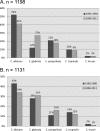Species identification and antifungal susceptibility testing of Candida bloodstream isolates from population-based surveillance studies in two U.S. cities from 2008 to 2011
- PMID: 22875889
- PMCID: PMC3486211
- DOI: 10.1128/JCM.01283-12
Species identification and antifungal susceptibility testing of Candida bloodstream isolates from population-based surveillance studies in two U.S. cities from 2008 to 2011
Abstract
Between 2008 and 2011, population-based candidemia surveillance was conducted in Atlanta, GA, and Baltimore, MD. Surveillance had been previously performed in Atlanta in 1992 to 1993 and in Baltimore in 1998 to 2000, making this the first population-based candidemia surveillance conducted over multiple time points in the United States. From 2,675 identified cases of candidemia in the current surveillance, 2,329 Candida isolates were collected. Candida albicans no longer comprised the majority of isolates but remained the most frequently isolated species (38%), followed by Candida glabrata (29%), Candida parapsilosis (17%), and Candida tropicalis (10%). The species distribution has changed over time; in both Atlanta and Baltimore the proportion of C. albicans isolates decreased, and the proportion of C. glabrata isolates increased, while the proportion of C. parapsilosis isolates increased in Baltimore only. There were 98 multispecies episodes, with C. albicans and C. glabrata the most frequently encountered combination. The new species-specific CLSI Candida MIC breakpoints were applied to these data. With the exception of C. glabrata (11.9% resistant), resistance to fluconazole was very low (2.3% of isolates for C. albicans, 6.2% for C. tropicalis, and 4.1% for C. parapsilosis). There was no change in the proportion of fluconazole resistance between surveillance periods. Overall echinocandin resistance was low (1% of isolates) but was higher for C. glabrata isolates, ranging from 2.1% isolates resistant to caspofungin in Baltimore to 3.1% isolates resistant to anidulafungin in Atlanta. Given the increase at both sites and the higher echinocandin resistance, C. glabrata should be closely monitored in future surveillance.
Figures
References
-
- Abi-Said D, et al. 1997. The epidemiology of hematogenous candidiasis caused by different Candida species. Clin. Infect. Dis. 24: 1122– 1128 - PubMed
-
- Banerjee SN, et al. 1991. Secular trends in nosocomial primary bloodstream infections in the United States, 1980–1989. National Nosocomial Infections Surveillance System. Am. J. Med. 91: 86S– 89S - PubMed
Publication types
MeSH terms
Substances
LinkOut - more resources
Full Text Sources
Other Literature Sources


